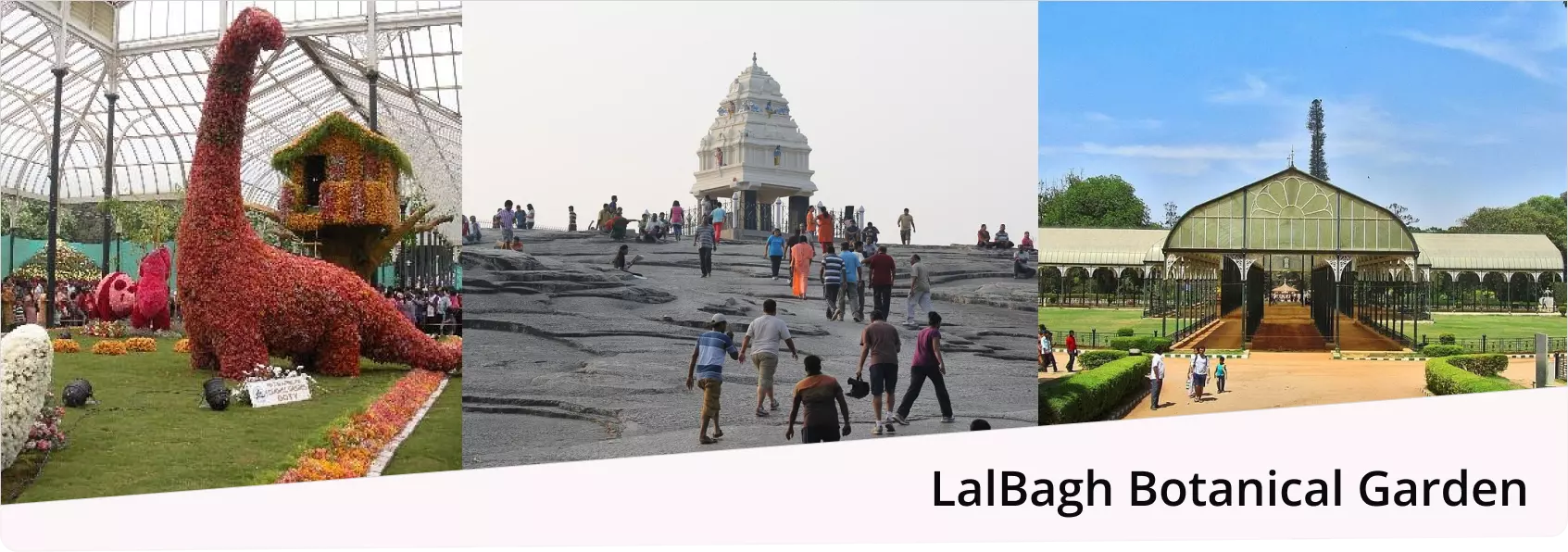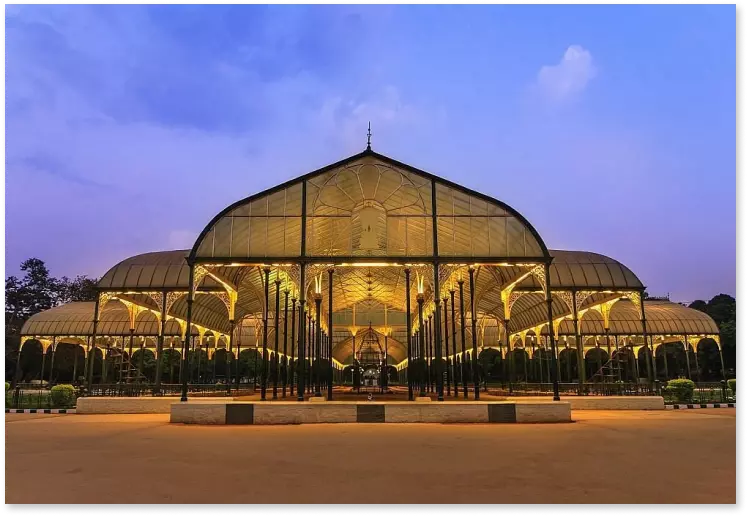
Surrounded by the tall towers of glass and cement and amid a chaotic world lies a heaven of color and fragrance that screams peace and rejuvenating. Lalbagh Botanical Garden, located in the tech-city of Bangalore, is a nationally and internationally known Centre for botanical artwork, scientific study of plants, and preservation of plants. A paradise for all nature paramours and located at the heart of the city, Lalbagh is spread across 240 acres of land with over 1854 species of short and tall plants and trees. The commencement for the construction of Lalbagh began in the year 1760 under the commission of Haier Ali but was complete by his son Tipu Sultan in the 18th century.
The garden is given the status of a Government Botanical Garden and houses an array of rare plants of French, Persia, Afghan, Turkish, Kabul, and of many more origins. These flower plants have been imported since the medieval ages and have been acclimatized and reproduced to create the haven what Lalbagh is today. The garden has in-house water bodies and fountains which are catered to by a systematic arrangement and organized water irrigation system, which not only enhances the vibrant vibes of the garden but also provides water to all the plants regularly. During the rule of Tipu Sultan, he imported plants and trees from all over the world to plant in the garden and today, Lalbagh Botanical Garden is home to one of the largest assortments of rare plants globally.
Apart from the flora, Lalbagh is also visited by an influx of tourists and visitors because of the 3000-million-year-old rock formation that is one of the oldest rocks in the planet. An attractive and shiny Glass House inside the garden made completely of sturdy glass is also present where an eye-catching Flower Show is organized every year which is nothing less than a breathtaking experience. In addition to being in greenery, the garden also features an aquarium and an aviary which houses birds such as Myna, Parakeets, Crows, Brahminy Kite, Pond Heron, Common Egret, and Purple Moor Hen. All these things male Lalbagh Botanical Garden a spectacular place for an unforgettable experience.

One of the major attractions of Bangalore, also used to be referred to as Rose or Cypress Garden up till 1856, Lalbagh Botanical Garden was commissioned by Haider Ali in 1760 who admired the Kashmir Mughal Gardens very much and wanted to have a similar kind of wonder in his own city. The main source of influence behind his love for flowers was his father who used work for Dilawar Khan, a viceroy of the Mughals, and was particularly ardent about setting up beautiful gardens. This garden has also been modeled on another garden that was in Sira, about 120km from Lalbagh. Although, the commencement of the garden was done in front of Haider Ali, it was completed by Tipu Sultan, his son, during the 18th century.
Apart from an array of stunning plants and flowers, many species of rare and unique plants, trees, and shrubs were added, most of which were brought by Tipu Sultan himself. The garden was sprawled in 45 acres of land in 1874 and major additions and improvements were done in 1889 (30 acres) and 1891 (94 acres). By 1860, Lalbagh became home to many exotic animals and birds such as orangutans, peacocks, rhinos, deer, and emus. The famous Glass House in the garden was commenced in the year 1898 and was built by the famous architect John Cameron in the image of London’s Crystal Palace. The huge rock that is resting inside the garden is one of the oldest rocks in the world up to 3000 million years old and was there while the construction of the garden was taking place. It is now known as the Lalbagh Rock and is a major source of attraction in the garden.
Sprawled across 240 acres of land, Lalbagh Garden is in South Bengaluru and is built around a tower constructed by the founder of Bengaluru, Kempe Gowda. The garden is a patchwork of flowerbeds, lawn, lotus pools, and fountains meticulously arranged and constructed to create a symphony of colors and give the visitors a pleasant sight to behold. It is a haven for the nature lovers with well-developed exotic trees and plants, along with walking and jogging tracks and water bodies that offer a peaceful and refreshing vibes to the place. One of the most detailed parts of this garden’s layout is perhaps its refined watering system which provides hydration to over 1000 species of flora including flowers, shrubs, plants, and trees that are more than 100 years old.
All the plants, shrubs, flowers, and trees in the garden are labelled for easy identification. It also has a giant working clock comprising several flower plants and shrubs and measures up to 7 meters in diameters. The space encircling the clock is also adorned with figurines from the Snow White and the Seven Dwarfs making it a fascinating and captivating sight for both children and adults. Lalbagh Botanical Garden has four gates namely the Eastern Gate, Western Gate, Northern Gate and Southern Gate.
The eastern gate opens on a wide road that connects to Jayanagar area which is close by.
The western gate is located near Siddapura Circle and a wall on the north-western side adjoins the Krumbiegal Road which is near to the garden.
The northern gate is the entrance to a wide and big road leading to the Glass House inside the Lalbagh and is considered as the primary entrance to the garden.
The southern gate is the smallest gate and opens near Ashoka Pillar – which is a 20 feet tall stone structure with four lions on top that represent our national emblem and is located at the center of the road which connects to Jayanagar. This gate is also considered as the main gate as it opens into the Lalbagh road.
Whether you are a nature lover or not, if you have not visited Lalbagh Botanical Garden, you are missing out on a lot. since its initiation, Lalbagh has been in expert hands and has always been full of well-nourished vibrant and flourishing plant variety by a continuous addition to its collection. Even during the erstwhile days, the rulers imported several plant species from far off places such as Persia, Turkey, Cape Town, Kabul, Mauritius, etc., to make the garden a home to numerous varieties of exotic plant species from across the globe. Non-native species of plants have been curated, introduced, acclimatized, and then further multiplied resulting in a stock of 1854 species which continues to grow.
Some of the exotica of plants here include Amherstia Nobilis, Adansonia Digitata, Ficus Bengalensis var – Krishnae, Araucaria Cookie, Bombax Ceiba, and Dillenai Indica among many others. The presence of these rare and exotic plants in the garden make enhance the exquisiteness of this place and make it one of the most significant horticulture hotspots not only in the country but around the world.
Situated in the southern part of the Bangalore city, Lalbagh Garden is easily accessible by the local means of transportation such as buses and auto rickshaws. Cab can also be hired to reach the place from bus stations and train stations as well. The timings to visit Lalbagh are from 6 am to 7 pm with an entry fee of Rs25 for adults and free for children below 12 years.

A spectacular expansive garden located at the heart of the city of Bengaluru, Lalbagh Botanical Garden is a storehouse of exotic and rare plants and trees with more than a 200-year-old history. Exhibiting a harmonious medley of flowerbeds, water bodies, and decorative shrubs, Lalbagh is a magical experience of hues and aromas that delights the senses in all forms and ways.
Copyright 2012-2022 Indiamap Digital Pvt Ltd. All rights reserved. Privacy Policy | Terms of Use